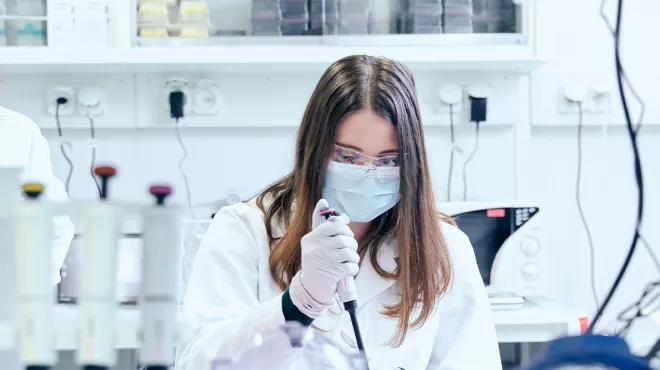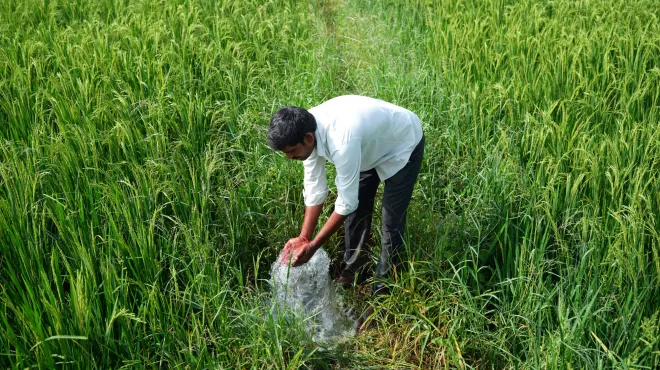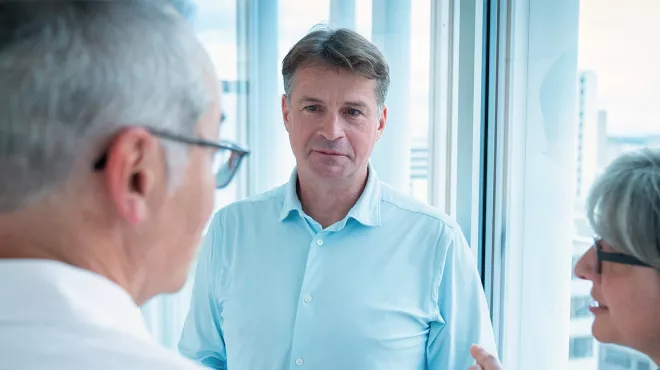As a physician-scientist who has spent much of my career working on drug and vaccine development, including during the H1N1 pandemic, I’ve been getting many questions about my take on the COVID-19 response. I wanted to answer a few of the most common questions in case they’re on your mind as well.
How is the life sciences industry working together to combat COVID-19?
As I recently shared in an article on COVID-19, I believe we’re in the midst of by far the largest and fastest mobilization of global scientific capabilities against a public health crisis. As the pandemic continues to have a crippling effect on health systems, economies, and livelihoods - sadly taking many, many lives too soon - we are seeing a significant collective response across government, academia, the private sector, and philanthropy. There is an unparalleled willingness to openly share scientific data, trials are being initiated at record speeds, and businesses are offering up their resources to help in any way they can. The industry is truly coming together on this.
Today there are over 140 vaccines and drugs being evaluated and hundreds of clinical trials happening around the world, according to Pharma Intelligence. Several major initiatives are supporting these efforts: The Biomedical Advanced Research and Development Authority, a division of the U.S. Department of Health and Human Services, is investing up to $3.5 billion in diagnostics, vaccines, drugs, and manufacturing. The Bill & Melinda Gates Foundation has formed a consortium with life sciences companies around the world, which I feel privileged to be co-chairing, to accelerate the development, manufacture, and delivery of vaccines and treatments. The Coalition for Epidemic Preparedness Innovations (CEPI) has launched a major effort to accelerate the development of vaccines for COVID-19. The Innovative Medicines Initiative of the European Union, which encourages industry-academic collaboration, has launched a major effort to fund the development of therapeutics and diagnostics.
All of us feel a deep and shared responsibility to accelerate solutions to this pandemic, whether by sharing compound libraries, committing research capacity and facilities, bringing together manufacturing capacity, or other forms of collaboration. We’re galvanizing our collective innovation power and global footprint to end this pandemic as quickly as possible.
When can we expect new treatment options for COVID-19?
When it comes to new treatment options, there are two phases that I believe can start to make a difference for patients in the near-term, probably over the next year. The first phase is looking at ways we can repurpose existing drugs to kill the virus or treat the overreaction that the immune system is having to the virus, which is leading to the hospitalization of patients. This is what the industry is focusing on initially, including Novartis. Trials are already underway to study around 15 existing molecules, and we can expect to see data begin to come out of trials like that later in April, with regulatory action to follow.
The scientific community needs proper data and testing to know for sure - and that will take time - but there are three classes of existing drugs that I think have the opportunity to have an impact in the near-term. The first is antimalarials, and there is preclinical evidence that suggests some antimalarials could benefit COVID-19 patients. The second is antivirals. The New England Journal of Medicine came out with early data on one combination therapy, and other efforts are ongoing to determine if these drugs could be effective. The third class is immunomodulatory agents that could help treat severe immune overreactions resulting from coronavirus infections, which could in turn reduce the number of patients requiring intensive care and ventilation. Novartis is looking at our anti-IL 1, which can inhibit part of the body's immune system defenses, and others are looking at anti-IL-6 agents, and we're also working to evaluate our JAK inhibitor - an approved anti-cancer drug that preliminary clinical evidence suggests could play a role.
The second wave of medicines will hopefully be novel therapies. There is a lot of work ongoing in this area, with dozens of drug candidates under evaluation to determine if they can move into the clinic. This is one of the focus area for the Gates consortium. We probably won’t see data readouts on the effectiveness of these novel therapies until around the end of this year or early next year.
So for now, as patients around the world seek immediate relief, our best hope for treatment options in the short-term is identifying existing medicines that effectively combat COVID-19. In the future, the hope is that a vaccine will be developed.
Why does it take so long to generate data?
To confirm that a medicine is safe and effective, we need to run large double-blind, randomized, controlled studies. These studies will need to use rigorous standards for data collection and analysis and be reviewed by regulators. While there are many hundreds of studies being run today, most are either too small, not randomized, not blinded, or lack a control. All of these factors matter to ensure we can control for bias and the differences within and across populations of patients. What is exciting now is that many companies have either already started or are soon to start the kind of definitive studies we need - including Novartis.
What’s the outlook on a COVID-19 vaccine?
Global distribution of a COVID-19 vaccine would be the definitive way to deal with this pandemic. That will require a longer timeline - I’d estimate roughly one and a half to two years - which is why the treatment-related efforts I mentioned above are also critically important. The appropriate clinical studies are required to ensure a vaccine is safe and effective, and that takes time. Developing a safe and highly immunogenic vaccine against an RNA virus, like the COVID-19 virus, is very possible - but it is not straightforward. There are already somewhere around ten candidate vaccines that are heading toward or are already in the clinic. If proven effective, any of those vaccines would likely become available in the second half of 2021.
As we look beyond the development of a vaccine, what has historically been a challenge has been manufacturing capacity. I’m hopeful that we can find new ways to rapidly scale manufacturing around the world - in fact, sharing and scaling manufacturing capacity is another area the Gates consortium is working to tackle.
What’s your take on testing?
There are two types of diagnostic tests that would typically be deployed in situations like this. The first is to see if individuals currently have an active infection - a test that is critically important for patients and their families, for health care professionals, and for public health officials working to model, control, and respond to the pandemic. Some COVID-19 cases have reportedly been asymptomatic, which increases the need for widespread testing and awareness - not only for the health and safety of individuals, but also because more data would help scientists better understand the virus, learn how it spreads and potentially mutates, and focus their research.
The other test determines whether or not somebody had an infection in the past and still has circulating antibodies - antibodies we hope could be a kind of natural vaccination or have the ability to fight the virus. A test like this for COVID-19 is being developed, with some early options starting to be used, and it could help provide the data needed to more widely model the pandemic. For example, it could help scientists determine how many people have already had this virus, which would in turn help guide public health measures. The world is in a bit of a data vacuum as we try to get a handle on the situation, and a lot of assumptions being made given the lack of data, so I'm hopeful we can tighten that up in the coming months.
What can be done to ensure non-COVID-19 patients continue to get their regular medicines and treatments?
Patients and patient groups have rightfully raised concerns about shortages as drugs approved for other health indications possibly become treatment options for COVID-19. Speaking for Novartis, we’ve committed to do everything we can to help ensure ongoing treatment is not disrupted and patients can still get the medicines they rely on. We are carefully monitoring our levels of manufacture and supply, and as of now, we have no significant disruptions in our supply chain thanks in part to preemptive measures we’ve long had in place - such as safety stocks and supply chain redundancies. I’m extremely proud of and grateful to all the Novartis associates who are working around the clock to keep our operations running to help ensure patients get the medicines they need.
Minimizing disruption to health-critical supply chains is also crucial as countries control and even close their borders. I'm hopeful countries will maintain open trade borders, because our supply chains are interconnected. Large-scale manufacturers like us (for reference, Novartis produces 72 billion doses of medicine for the world every year) need to be able to move around the various parts of the drug production process.
The last thing to note is that in situations like this, when the world shifts so much of our health, human, and financial resources toward a public health challenge, the communities and systems that are traditionally underserved are often hit the hardest and need support. While the world focuses its attention on the pandemic, we must not regress on global health priorities like HIV/AIDS, malaria and sickle cell disease that affect millions around the world.
As humanity continues to respond to this pandemic - as health care workers bravely care for patients on the front line, as researchers work around the clock to advance the science, and as all of us do our part by taking social distancing seriously and supporting our loved ones, neighbors, and colleagues in the ways we can - I want you to know that I remain optimistic about our future. Not only are we living in an era in which human health and life expectancy are greater than ever before, but we are also more connected with powerful digital tools at our disposal. If we center on the science, follow public health guidance, and continue working together, I’m confident we will get through this.
This Q&A was first published by Vas on April 09, 2020 as a LinkedIn Influencer article
Novartis CEO @vasnarasimhan answers the top questions he’s received about the #COVID19 pandemic



